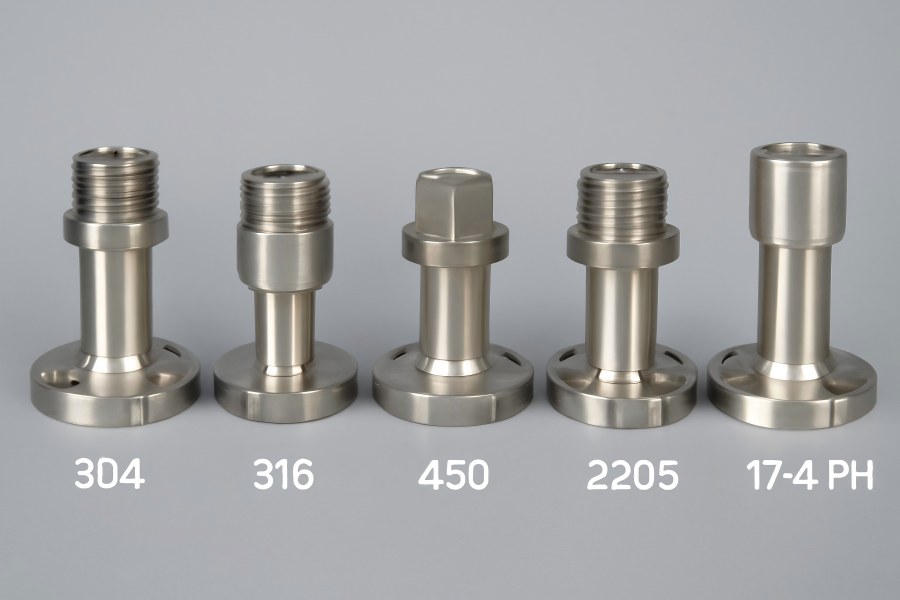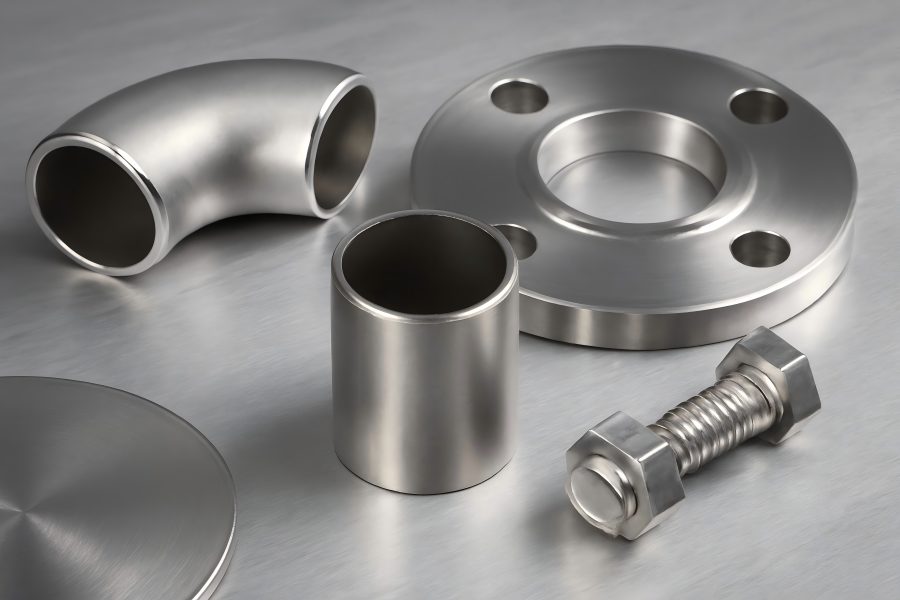Stainless steel is a common material for manufacturing because of its strength, corrosion resistance, and versatility. It is crucial for sectors including medical devices, food processing, construction, and automobiles. Composed mainly of iron with varying amounts of chromium, nickel, and other elements, it offers specific properties for different applications.
Choosing the appropriate type of stainless steel for your purposes requires an understanding of its grades. This guide will explore the most common grades, their properties, uses, and factors to consider in your choice.
What is Stainless Steel?
Stainless steel is an iron alloy that usually contains 10–30% chromium in addition to additional elements including manganese, nickel, and molybdenum. The primary feature that distinguishes stainless steel from other materials is its ability to resist corrosion. This resistance comes from the formation of a thin, protective chromium oxide layer that shields the steel from oxidation and rust.
Stainless steel has exceptional mechanical qualities, such as high tensile strength, formability, and the capacity to tolerate high temperatures, in addition to its resistance to corrosion. There are five main categories into which stainless steel falls:
- Austenitic: Distinguished by its exceptional formability, good corrosion resistance, and non-magnetic characteristics.
- Ferritic: Magnetic, less resistant to corrosion than austenitic grades, but still good.
- Martensitic: Magnetic and hardenable, but with lower corrosion resistance.
- Duplex: A blend of austenitic and ferritic stainless steels, offering a mix of strength and corrosion resistance.
- Precipitation Hardening: Known for its high strength, these alloys can be heat-treated to achieve better performance.
Key Factors in Selecting Stainless Steel Grades
When selecting a stainless steel grade, several key factors must be considered. These include:
Corrosion Resistance
The degree of corrosion resistance offered by various stainless steel grades varies. For example, austenitic steels like 316 offer superior resistance to saltwater environments compared to 304, which may be adequate for indoor applications but may corrode in chlorinated environments.
Strength and Hardness
The mechanical strength and hardness of stainless steel depend on the alloying elements and the heat treatment process. Grades such as martensitic steels (e.g., 410) are much stronger but less corrosion-resistant, while austenitic steels balance both properties well.
Formability and Weldability
Austenitic stainless steels are the easiest to form and weld, making them ideal for complex shapes and designs. On the other hand, martensitic steels, due to their higher carbon content, are more difficult to work with.
Cost-effectiveness
While higher-grade stainless steels like 316 and 2205 offer superior properties, they come at a higher cost due to their alloy content and processing requirements. Choosing the right grade involves balancing performance and cost, especially in large-scale manufacturing.
Overview of Common Stainless Steel Grades

The most popular grades of stainless steel and its characteristics are broken down as follows:
Austenitic Stainless Steels
Approximately 70% of all stainless steel produced is austenitic, making it the most prevalent variety. They contain high amounts of chromium (18-20%) and nickel (8-12%), which give them excellent corrosion resistance and the ability to resist oxidation in harsh environments.
304 Stainless Steel:
- Properties: Offers strong corrosion resistance across various environments and is highly weldable and formable, making it the most versatile grade.
- Uses: Kitchen appliances, food processing equipment, architectural elements, and medical devices.
- Advantages: Affordable, versatile, and widely available.
- Disadvantages: Not appropriate for situations with chloride, which can lead to corrosion in crevices and pitting.
316 Stainless Steel:
- Properties: Because molybdenum is added, it has better corrosion resistance, especially in settings that are chloride-rich and maritime.
- Uses: Marine applications, chemical processing, pharmaceutical equipment, and food industry.
- Advantages: Provides outstanding resistance to both corrosion and high temperatures.
- Disadvantages: More expensive than 304.
Ferritic Stainless Steels
Ferritic stainless steels have a low carbon and nickel content and are mostly made of chromium. They are magnetic and typically used where corrosion resistance is important but cost needs to be minimized.
430 Stainless Steel:
- Properties: Good resistance to oxidation, particularly in mild environments. It’s magnetic and can be used for simple parts.
- Uses: Commonly found in automotive parts, household appliances, and decorative applications.
- Advantages: Cost-effective and corrosion-resistant in most environments.
- Disadvantages: Limited corrosion resistance in chloride environments.
Martensitic Stainless Steels
Martensitic stainless steels are strong and hardenable, but they offer limited resistance to corrosion. They are frequently utilized in situations requiring great strength because they are magnetic.
410 Stainless Steel:
- Properties: High strength and hardness but lower resistance to corrosion compared to austenitic steels.
- Uses: Cutting tools, shafts, valves, and turbines.
- Advantages: High strength and wear resistance.
- Disadvantages: Poor corrosion resistance and difficult to weld.
Duplex Stainless Steels
Austenitic and ferritic structures are combined to create duplex stainless steels, which offer the finest qualities of both materials: strength and resistance to stress corrosion cracking.
2205 Stainless Steel:
- Features: Outstanding defense against stress corrosion cracking, pitting, and crevice corrosion. Weldability and strength are excellent.
- Uses: Commonly applied in chemical processing, oil and gas sectors, and marine environments.
- Advantages: High strength and superior corrosion resistance.
- Disadvantages: More expensive than other grades and not as formable.
Precipitation Hardening Stainless Steels
Precipitation hardening stainless steels are typically used in applications that require high strength and are subjected to heat treatment to increase their properties.
17-4 PH Stainless Steel:
- Properties: Noted for its high strength, exceptional corrosion resistance, and toughness. It’s heat-treatable for better performance.
- Uses: Aerospace, military, and high-performance applications.
- Advantages: High strength and corrosion resistance.
- Disadvantages: Expensive and difficult to fabricate.
How to Choose the Right Stainless Steel Grade
When choosing a stainless steel grade for a particular application, you must consider several factors:
- Environmental Conditions: Will the steel be exposed to harsh environments such as marine or chemical conditions? For example, if the material is exposed to saltwater, 316 stainless steel would be a better choice than 304.
- Mechanical Properties: Does the application require high strength, hardness, or wear resistance? In this case, martensitic or duplex stainless steels would be more suitable.
- Formability: If the application requires forming or welding, an austenitic steel such as 304 or 316 would be better, as these grades are easier to work with.
- Cost: Balancing performance with cost is essential. While 304 and 316 stainless steels offer good properties, they can be expensive. Ferritic and martensitic steels may be suitable for less critical applications and can be more affordable.
Applications of Stainless Steel Grades
There are many different uses for stainless steel, including:
Automotive Industry
Exhaust systems, body panels, and trim frequently employ 304 and 316 stainless steel because of its exceptional strength and resistance to corrosion.
Food and Beverage Sector
304 stainless steel is frequently utilized in food processing equipment because of its corrosion resistance and simplicity of cleaning.
316 stainless steel is used in areas exposed to harsh chemicals and environments, such as dairy or chemical processing.
Medical Devices and Equipment
Because 304 and 316 stainless steel are biocompatible, long-lasting, and corrosion-resistant during sterilizing procedures, they are perfect for use in surgical equipment and medical implants.
Building and Design
Stainless steel is widely utilized in the building of interior features, architectural facades, and structural elements. The most popular grades for these uses are 304 and 316 because of their strength and beauty.
Stainless Steel Grade Cost Considerations
The alloying components and manufacturing method have an impact on the price of stainless steel. For instance, because they include more chromium and nickel than ferritic grades, grades like 304 and 316 are more costly.
Here’s a cost comparison table to illustrate the differences in pricing:
| Stainless Steel Grade | Price Range (USD) | Typical Applications |
| 304 | $1.50 – $3.00 | Food processing, kitchen equipment, architecture |
| 316 | $2.00 – $4.00 | Marine environments, chemical processing, medical |
| 430 | $0.90 – $2.50 | Automotive parts, home appliances |
| 2205 | $2.50 – $5.00 | Oil & gas, chemical processing |
| 17-4 PH | $3.00 – $6.00 | Aerospace, military, high-performance applications |
Price Variation Factors:
- Nickel Content: Higher nickel content increases the price, making grades like 316 more expensive than 304.
- Alloy Additives: Molybdenum and other additives used in specific grades, such as 316, contribute to their higher cost.
- Production Process: The complexity of producing different forms (sheet, pipe, bar) can also affect the price.
Maintenance and Longevity of Stainless Steel
Stainless steel requires minimal maintenance, but its longevity depends on several factors such as environment, grade, and proper care.
- Cleaning: To preserve stainless steel’s integrity and look, use non-abrasive cleaning solutions. Steer clear of rough cleaning or harsh chemicals that could harm the surface layer.
- Examination: Long-lasting performance is ensured by routinely checking for corrosion, particularly at joints and welds. Schedules for maintenance should be modified in response to extreme conditions or chemical exposure.
- Expected Lifespan: The lifespan of stainless steel largely depends on its grade. For example, 304 stainless steel may last for decades in indoor environments, while 316 can endure longer in marine environments.
